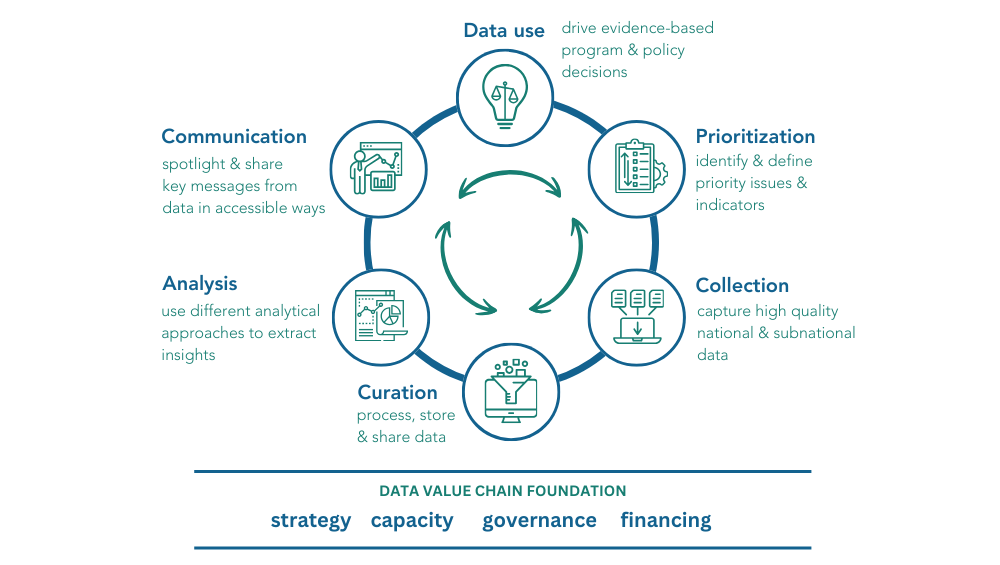For the last seven years DataDENT has championed the nutrition data value chain (DVC) as the guiding framework for our initiative. It is rare to see a presentation by a DataDENT team member that does not start with the DVC.
DataDENT did not create the idea of a DVC or even a nutrition DVC, but we have found it to be useful across our work. Over time, we have updated the nutrition DVC framework to reflect what we are learning about nutrition data and information systems in low-and-middle income countries (LMICs).
The most recent version of the framework – featured on our refreshed website – reflects three significant changes from the previous version:
1) decision making is now called data use and moved to the top of the circle, 2) translation & dissemination is now called communication and 3) we added a ring of two-way arrows in the center. We also updated the descriptors for each element and the DVC foundation.

Image. DataDENT Nutrition Data Value Chain (2025 version)
Here we explain some of the changes in our most recent iteration of the nutrition DVC.
Data use: The DVC begins and ends with data use. We shifted this element to the top to reinforce this idea that the needs of data users should define priorities and the subsequent DVC elements should ultimately make data more useful in guiding decisions. In Ethiopia and Nigeria, we discovered that the previous term “decision making” gave the impression that only senior officials with a certain type of authority were being considered; so we changed to a more inclusive term. A data user can be a frontline worker or a senior public official.
Prioritization: We updated the description of this element slightly to better reflect how standard indicators should be defined in line with the priority food and nutrition issues in a particular context. Not all indicators are important or useful in all contexts.
Collection: We simplified this element from creation & collection to simply collection; our descriptor continues to emphasize quality and representativeness of data.
Curation: We kept the term curation because we could not identify another commonly used term that captures the essence of this element. However, we refined the descriptor to emphasize the importance of data accessibility and data sharing, particularly in a multisector system where many different actors are responsible for producing data.
Analysis: We kept the idea of deriving insights that reflect a deeper understanding of what the data mean. Analysis may be done with statistical models, but it can also be done through review meeting discussions and other collaborative forums.
Communication: This is the element that prompted the most discussion amongst our team, as we considered whether and how to reframe the original “translation & dissemination” label. We agreed that the single word “communication” captured both concepts but that it is too general. So, we included the descriptor that emphasizes targeted sharing of messages to different audiences.
The two-way arrows were added to reinforce the idea that each element influences the others. For example, if you are using a national survey for data collection that will influence how you define an indicator during prioritization.
The foundation to the nutrition DVC – which was our first major adaptation of the framework – includes the same core concepts but we separated strategic leadership into components of strategy and governance and used capacity in place of capacity strengthening to be consistent with the other three terms.
The nutrition DVC framework has served our project well as the organizing structure for our activities and outputs across our three outcomes. It has also resonated with national audiences.
Check out our tools & resources tab for DataDENT outputs that can help you strengthen different aspects of the nutrition DVC in your context.
